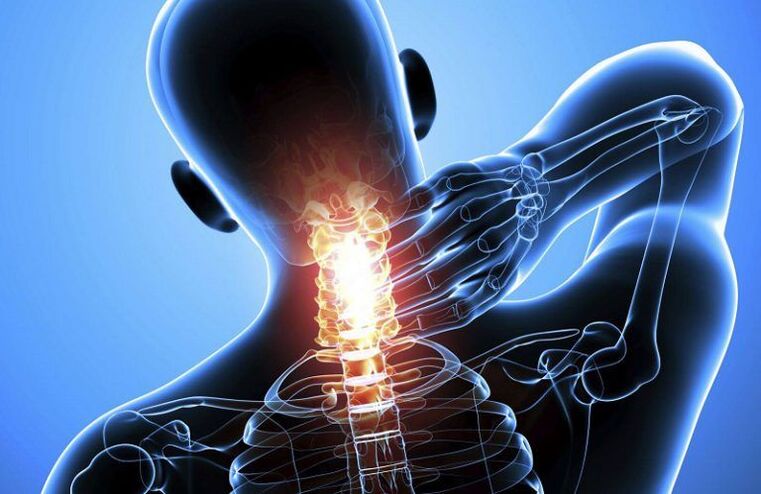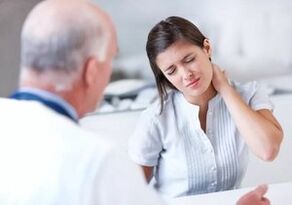With neck pain, every person has encountered it more than once in his life. If the back of the cervix hurts, then the cause, in most cases, lies in the back of the cervix. Let's take a closer look at each disease.
myositis
With hypothermia and colds, neck myositis develops - acute inflammation of the muscles. A person begins to have severe pain in the neck and shoulder, a slight fever rises. On palpation of the painful area, the skin on the muscle is edematous, swollen, hot to the touch. When you try to turn your head to the affected side, there is a sharp pain and tension in the neck muscles.

Myositis can occur against the background of a respiratory or viral disease. Then there is a pain in the throat, neck, swelling of the lymph nodes.
Treatment
Non-steroidal anti-inflammatory drugs will help stop inflammation quickly and effectively. Various ointments and gels can be used on site. Here it is necessary to add an important fact about the finalgon - it must be painted with a thin layer and can not be washed with water under any circumstances.
You can use semi-alcohol and heat compresses - with vodka, diluted alcohol or dimexide. Folk remedies also help: boiled potatoes, rubbing with honey, application of crushed cabbage leaves.
In addition to treating myositis, colds are also treated - antiviral or antibacterial drugs, vitamins, nasal and throat sprays. For the rapid relief of sore throat, a spray is a great help - a powerful antibacterial and antifungal medicine, the effect of which can be felt 20-30 minutes after starting treatment.
Osteochondrosis of the cervix
Everyone has heard about the disease, but the reasons for its development are still a mystery.
Predisposing factors are injuries, prolonged forced position, microtraumas of muscles and tendons during heavy physical work, dystrophic processes in the spine, old age, menopause.

With prolongation, instability, hernia of the cervical spine, compression of the nerve roots occurs, blood flow to the vertebral artery is disturbed, which leads to cerebral ischemia.
All the symptoms of cervical osteochondrosis are divided into:
- reflex;
- radicular and vascular compression;
- spinal.
More:
- Reflex symptoms occur with prolonged irritation of pathological spinal tissue receptors. Nerve impulses from the affected vertebra enter the spinal cord, causing changes in the surrounding muscles and tissues. The healthy side muscles take over all the functions, forming a pathological stereotype of movement. And the muscles on the affected side adjust the displaced vertebra to a certain position, preventing its further bending. But they also do not give the opportunity to take a physiological position. If at this time a person does not go to a doctor and chiropractor, muscle atrophy occurs, degenerative changes are formed in the vertebral tissues, osteochondrosis of the cervix. In the future, the progression of the disease causes inflammation and fibrosis of the shoulder girdle muscles, inflammation of the periarticular sac is formed. Reflex symptoms:
- pain along the spinous processes - palpation of the neck will cause discomfort, pain, shooting in the vertebrae;
- tension and pain in the back of the neck muscles, aggravated by attempts to turn the head or probe;
- cervicalgia - pain or sharp pain in the neck, may decrease periodically, giving the person a break. But with loads, a long stay in a sitting position (for example, during flights, long trips by bus or car), the pain will not last long. With cervical pain, a person may periodically hear a crack in the neck, feel discomfort and numbness of the skin;
- cervicocranialgia - aggravation and pain in the neck that spreads to the head. Most often, the back of the head suffers - there is aggravation, a feeling of "pulsation", numbness, a person wants to support the head with his hand or lean on a solid surface. Periodically there are "hot flashes" - it seems that the back of the head and neck are burning or freezing. Sleep also suffers - it is interrupted, superficial, the patient wakes up in the morning sluggish, apathetic, tired. The pain can spread throughout the head - photophobia appears, tightness in the gallbladder, neck, eyes, blood pressure rises, nausea and vomiting often occur;
- cervicobrachialgia - pain in the cervical region spreads to the shoulder and arm. There is pain and spasms of the shoulder muscles, stiffness, pain in the shoulder joint, crackling, difficulty in trying to raise or lift the arm.
- Compression of the roots and vessels of the spinal cord is manifested by vertebral artery syndrome. This is a large complex of different manifestations of compression of the vertebral vessels. There are 3 groups of symptoms that directly indicate the disease:

- throbbing and aching headaches of a persistent or paroxysmal, burning, unbearable nature. Grows with uncomfortable prolonged position, spreads from the occiput to the forehead;
- Cochleovestibular changes - dizziness, instability while walking, various noises in the ears (clicking, noise, buzzing). Dizziness in a patient is constant or paroxysmal, deteriorating a person's quality of life;
- Vision pathology - darkening and "flies" before the eyes, discomfort and a feeling of "sand", burning, decreased vision.
There are several types of vertebral artery syndrome manifestations:
Barre-Lieu syndrome - there is pain in the posterior region of the cervix and the occiput, which passes into the anterior sections of the head - "removal of the helmet". It intensifies at night and after sleep, especially if the person slept on an uncomfortable pillow. When the head turns, dizziness and tinnitus appear in the ears, darkening in the eyes.
Basilar migraine - before the migraine attack, dark eyes appear, blackheads, photophobia. The attack begins with severe dizziness, tinnitus, impaired articulation of the tongue (a person has difficulty pronouncing words). Severe pain in the back of the neck, in the back of the head, makes a person take immobility to reduce the attack. At the peak of the headache appear vomiting, in severe cases - fainting.
Coleovestibular symptoms - aching pain in the back of the neck, crackling when tilting and turning the head, dizziness, hearing loss and impaired speech comprehension. Often patients are unable to distinguish between whispered speech.
Ophthalmic syndrome - against the background of cervical osteochondrosis, vision is impaired. A person develops rapid eye fatigue while reading, loss of access to visual fields, conjunctival redness, and tearing.
Spondyloarthritis
The disease is characterized by "forgetfulness" of cartilage with bone growth along the edge of the articular surface. The disease occurs at any age, but most often debuts in the elderly. Trauma, inflammation, congenital changes in the joints can cause the development of spondylarthrosis.
Symptoms
The patient is bothered by excruciating pain in the cervical spine, which is aggravated by turning and tilting the head. Often a person can not turn their head completely to the side, an attempt to increase the range of motion causes back pain. In the supine position, the pain subsides. In addition to the neck, the region of the spine, the knee joints and the hips are involved in the process.
As the disease progresses, narrowing of the intervertebral canal occurs in the cervical and lumbar regions. Spondylogenous myelopathy develops - a chronic disease of the spine with a weakening of muscle tone and dysfunction of internal organs. Myelopathy provokes an increase in pain in a person, reduces the speed of blood flow to the vessels of the neck and head.
Spondyloarthritis
Prolonged pain in the back of the neck, inability to fully bring the head to the chest - the symptoms may also speak of rheumatoid arthritis of the spine. The disease develops against the background of polyarthritis - multiple lesions of the joints.
Symptoms
The pain appears in the back of the neck, spreads to the back of the head, intensifies when the head is tilted back and forth, turning left and right. A person can not move his head completely, the neck muscles are tense and painful. In severe cases, a life-threatening complication develops - bulbar syndrome. Its manifestations are varied and depend on the degree of elongation of the medulla oblongata during atlas subluxation. The patient's speech is disturbed - it is vague, slow and the person gets tired of talking quickly. Swallowing is also a concern, especially liquid food. A person drowns, fluid leaking through the nose or corners of the mouth. Cardiac activity is disturbed - arrhythmias, tachycardia occur.

In children, cervical spondyloarthritis develops as a complication of acute sinusitis - inflammation of the sinuses. The disease is called Grisel torticoll according to a French doctor. The disease is formed by a defect in the articulation of the atlas and the axial vertebrae.
The symptom of the disease is specific and allows you to quickly make a diagnosis: the baby's head is tilted towards the source of inflammation and is slightly turned towards the healthy side.
The treatment of cervical osteochondrosis and spondyloarthritis is the same. The patient needs consultation and treatment with a manual therapist. The specialist will quickly and painlessly place the vertebrae in place, eliminating the need for expensive treatment in the clinic. If necessary, every six months or a year, a neurologist at the clinic prescribes a course of medication: these are injections given intramuscularly or intravenously and tablets.
Helps well in the treatment of cervical osteochondrosis, collar area massage, acupuncture. You can use self-massage - rub the neck muscles from the back of the head to the shoulders with gentle circular motions. You can not massage the neck muscles forcefully - you can provoke an increase in blood pressure and intracranial pressure.
Patients often use the applicator - the point effect of the needles reduces muscle tension, stimulates blood circulation. It is necessary to use applicators only after consulting a doctor and make an accurate diagnosis - needles are contraindicated in the oncological process, as they stimulate tumor growth.
In the case of vertebral artery syndrome and cerebral ischemia, nootropic therapy is mandatory: intravenous injections of drugs that stimulate vascular circulation, increase brain oxygenation, reduce attacks of dizziness and tinnitus.
Spinal tuberculosis
With tuberculosis spreading to the bones and joints, it is the spine that is most often affected. The risk of disease is in a long period of silence. Tuberculosis does not appear in any way for 2-4 years. As the disease progresses and the vertebral bodies are destroyed, aggravation appears in the neck and shoulders, vague pain in the spine without a clear localization.
A person is not able to hold his head for a long time, he tries to constantly support it with his hand. Due to severe neck pain, the patient avoids turning and tilting the head. As the vertebrae are destroyed, the process spreads to the surrounding tissues, forming an abscess - an abscess in the capsule. A swelling appears in the back of the neck, with a dense elastic consistency, slowly increasing in size. An abscess can spread to the pharynx, cough, difficulty swallowing and sore throat.
The treatment of the tuberculosis process is performed in a specialized tuberculosis dispensary. Treatment is difficult and lengthy, with many side effects. Powerful bactericidal preparations of synthetic production are used. Course doses with 2-3 drugs are prescribed. In the treatment process, monthly blood and urine tests are performed, examination for mycobacterium tuberculosis. Once every two months, the patient undergoes an X-ray examination.
Cervical spine cancer
Tumors can appear at any age. A neoplasm can grow from cartilage, bone and nerve tissue. The tumor may be an independent disease or be a metastatic focus from another organ. Most often, metastases in the cervical region give rise to cancers of the breast, prostate, lung and stomach.
Symptoms will increase with the spread of the tumor: a person constantly has pain in the neck, difficulties appear when tilting and turning the head. There is weakness, sweating, fatigue. Tumor growth and compression of roots and blood vessels will lead to tremors and weakness of the arms and shoulder girdle, persistent headaches, dizziness.
Treatment
Apply:
- surgical intervention - complete radical removal of the tumor within healthy tissue;
- chemotherapy - cytotoxic drugs that slow down the division of tumor cells and prevent its further development;
- radiation therapy - the effect on tumor cells with ionizing radiation;
- symptomatic treatment - most often used painkillers in the late stages of cancer, narcotic analgesics.
Spinal cancer is an extremely dangerous disease, the manifestations of which are often attributed to osteochondrosis and treatment is late. Therefore, when pain appears in the cervical spine, it is necessary to do an x-ray or magnetic resonance imaging. This will allow you to quickly diagnose and begin proper treatment.
In polyclinics, MRI is rarely prescribed for financial reasons - but this examination is performed for a fee in many private centers. It is better to pay a few thousand rubles and protect yourself than to treat the disease for a long time, not knowing what is the source of trouble.























